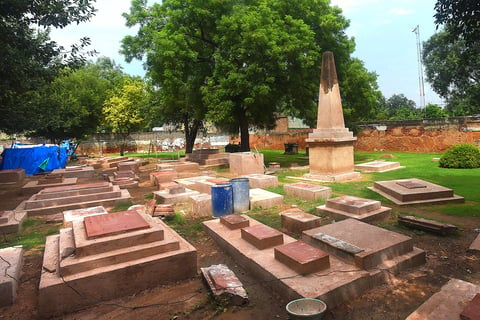This website is available in Hindi or English language
Lothian Cemetery,Delhi
Established in 1808, Lothian Cemetery is the oldest British cemetery in New Delhi. It was used for over a century before it was closed in the 1960s.
The cemetery houses burials of people from the local Christian community between 1808 and 1867. Throughout the cemetery are graves of members of the East India Company and their families who died during the first cholera outbreak in India during the 19th century. The cemetery also houses burials of British soldiers who died during the Indian Rebellion of 1857. The main objective of the rebellion was to end the rule of the East India Company.
Like many other cemeteries around the world, Lothian Cemetery is also rumored to have ghost sightings and hauntings. One famous ghost story is that of Sir Nicholas. Nicholas was a British officer whose ghost is said to now roam the cemetery, his head missing
As the story goes, Nicholas fell in love with a local Indian woman who later married someone else. It is said that a heartbroken Nicholas committed suicide over his lost love. This tale is likely derived from the Nicholson Cemetery, which is less than a mile away and hosts a similar tale.
The cemetery is owned by the Archaeological Survey of India. It was in a state of disrepair for some time until renovations began in 2017.
Know before you go
Visitors are welcome to visit the cemetery from 10am to 5pm. Entry is free.
### Summary on Lothian Cemetery: Memories and Legends Intertwined
Located in the `heart of Delhi`, `Lothian Cemetary` is more than just a place where the dead lay; it’s a historical, vengeful, and even supernatural rated site. Built in the 18th century, this complicated site is known for housing several British colonists along with prominent personalities from that era. The Magnificent structures, extended land, and the silent stories do attract historians as well tourists and even ghost lovers to the site of the cemetery.
### When to Go
There are several pros of visiting Lothian Cemetery which would be time related:
1. Evening Visits: The cemetery offers a striking view of the setting sun-picture in mid to late afternoons and early evenings. When the dusk sets in, the changing of the sky complemented by the Rova of the light brings a more thrilling beauty, enticing one into the interesting stories of the cemetery.
2. Weather Considerations: Visiting is best during the dry season (October to March) when the temperature is bearably low and one can walk comfortably around. The stillness of the grounds in this particular season offers a mellow mood that is rather good for appreciating the lengthy and rich history imprisoned within the walls of the burial site.
### A Glimpse into the Haunted Lands of Loviana Cemetery
1. Whispers of the Past: Lothian Cemetery is believed to be sited on water been especially sanded or even metaphorical inclusions which are common with many cemeteries that have a mountain of associated legends. Quite a number of tourists have been quite uneasy at a particular point, in some cases, hearing constant voices and the feeling of being stared at. Such occurrences often take place in the vicinity of large burial structures and mausoleum-like tombs located somewhere within the area adding some intrigue to the place.
The Ghost of Lady Dyer: Among the various stories related to Lothian Cemetery, none comes close to the tragic tale of Lady Dyer, a British officer’s wife who died in the 19th century. Rumor has it that she is somewhere in the cemetery looking for her husband. Some witnesses have reported seeing a white-clad female silhouette hovering around Lady Dyer’s grave, often accompanied with a frightful gust of wind. This narrative depicts the pain of absence but also the concern of memory and love.
Scientific Anomalies: Many of the tourists as well as the local people report strange incidents, for example, there are observations about the sudden drop in the ambient temperature, the moving of shadows at odd places and sounds without explanations. These events have enhanced the content of the cemetery as a place said to be haunted and thus appealing to people who wish to engage in the supernatural.
Cultural Relevance & Community Participation
Lothian Cemetery is of great cultural importance, as a cemetery and as a historical site that preserves the colonial history of Delhi. The history of the place can be pieced out from the ornamental gravestones and inscriptions. During these tours, local historians and the museums’ employees, together with the tourists, walk around the territory of the cemetery, talking about the people buried there and increasing the understanding of the place’s history. Such activities that involve the carrying out of these tours ensure that the society is involved in the activities, with the past being experienced in the present and the site being appreciated in the right manner.
Problems and Green Solutions in Modern History
On the one hand, the popularity of Lothian Cemetery encourages many individuals to explore its areas. On the other hand, such activities create a difficulty in maintaining its structure. For example, more visitors may result in the damaging of some of the monuments and the surrounding nature due to more people treading the ground. Therefore, it is important for visitors to practice forms of tourism that will not compromise the site, for example, by walking only on the marked walkways and not behaving in a way that is inconsistent with the nature of the location. Efforts to protect the extant structure of the cemetery are being made by the community and preservation groups, as well as to make sure that the stories it contains are preserved for generations to come.
To Sum Up
As for the last point, Lothian Cemetery is an exceptionally beautiful place filled with novels of history and stories of almost every ease in the world. In addition to the lifes leaving these tombs, there are also many dark and scary stories and some of them even complete with ghost sightings, which manage to lend an extra essence to this cloud of gaiety. When shifting through the cemetery, with all of the artistic designs alongside the plant life, this in turn creates inviting beckoning towards the past. It may be hard to believe but the only use of cemetery is not to bury the dead but also to tower years after living with the presence of closest ones in memories.
In “Nobody goes to Lothian Cemetery” the reader has the opportunity to investigate a story, which implicates notions of love, loss, and most importantly, the idea of people who no longer walk the earth. The plot of the stories includes a character in any of the stories, a haunting, which implores that such memories do exist. Whether it is an appreciation of a historical site, an encounter with the haunting, or a peaceful moment, Lothian Cemetery is a remarkable exploration of time and memory because every rock has a history behind it and every sound has a history.


